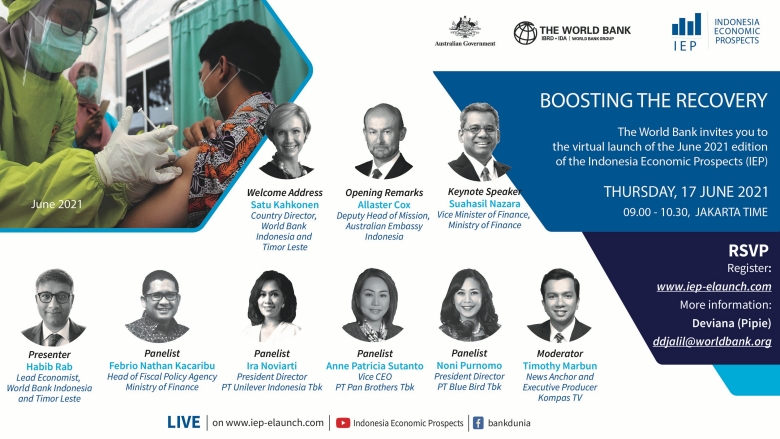Key findings
- COVID-19 led to one of the most severe global recessions in living memory.
- Indonesia’s economic recovery until the first quarter of 2021 has been relatively gradual although leading indicators suggest a stronger rebound during the second quarter. Indonesia’s recovery gap – the difference between real GDP and its pre-crisis trend – narrowed from -7.5% to -7.1% between Q2 and Q4 2020 compared to from -13.6% to -5.1% among G20 peers. It remained elevated at -7.9% during the first quarter this year. On the upside, retail sales increased by 11% between March and April while manufacturing activity continued to expand, driven by more upbeat external demand and commodity prices.
- The pandemic risks still loom large with cases increasing significantly in June. Indonesia remains vulnerable to new waves driven by more transmissible strains as experienced by other countries as well as potentially higher mobility and viral transmission during festivities. Despite an earlier and stronger start than regional peers, the free vaccine rollout has started to lag when compared with some of the large G20 peers.
- Despite a strong crisis response, monetary policy had to strike a difficult balance between managing external financing pressures and stimulating the recovery. Monetary financing of the deficit supported the fiscal response under the exceptional circumstances. Bank Indonesia (BI) also loosened monetary policy although the real policy rate is high relative to peers and considering the low inflation and large negative output.
- Private credit growth has fallen despite healthy bank balance sheets and moderate corporate vulnerability due to a combination of credit demand and supply constraints, including weak effectiveness of monetary policy transmission, low take-up of risk sharing mechanisms such as guarantees and historically low reliance on banking credit among MSMEs.
- The fiscal response to COVID-19 has been strong but spending adjustments have been made in 2021 potentially due to revenue and financing constraints. The COVID-19 fiscal response package was increased from 3.8 to 4.5 percent of GDP between 2020 and 2021, including to provide funding for the free vaccination campaign. But it includes cuts to social assistance spending of about 0.3 percentage points of GDP. Despite relatively low public debt, fiscal space is limited by a combination of narrow revenue base and shallow debt market which have led to high monetary financing of the fiscal deficit compared to peers.
- Growth could accelerate to 5.0% in 2022 driven by reduced uncertainty and assuming that the vaccine rollout reach a critical mass of the population in the fourth quarter of 2021. However, uncertainty remains very high and downsides risks are tilted to the downside.
- To boost Indonesia’s recovery and improve medium-term economic prospects, the report recommends to:
- Accelerate the vaccine rollout, and improve testing-tracing-isolation, and other non-pharmaceutical interventions such as adequate mobility restrictions to get ahead in the race against infections.
- Maintain accommodative monetary policy stance and stimulate private credit to support the real sector.
- Maintain fiscal support in the short term while ensuring medium-term fiscal sustainability. Short-term fiscal is critical to mitigate risks of rising poverty and support demand. A credible medium-term fiscal strategy – including clear plans to raise more tax revenues – could improve fiscal space and investor sentiment.
- This edition of the report also discusses how Indonesia can boost higher productivity middle-class jobs and women economic participation. The report recommends:
- Accelerate productivity growth across the board by promoting competition, trade and investment.
- Equip the workforce with the skills needed for higher productivity jobs by improving learning and workforce development systems.
- Bring more women into the labor force and reduce earning gaps between men and women, including by developing child and elderly care services.
- Mitigate job losses during the crisis by maintaining adequate jobs retention programs until the recovery is stronger as well as social assistance, training, and reskilling programs for affected workers

